Ijraset Journal For Research in Applied Science and Engineering Technology
- Home / Ijraset
- On This Page
- Abstract
- Introduction
- Conclusion
- References
- Copyright
A Triadic Approach for Enhancement of Underwater Images Using Adaptive Colour Correction with Unsharp Masking and CLAHE Implementation
Authors: Sumbul Zaheer, Shweta Dwivedi, Yashvi Srivastava, Prof. Awanish Kumar Shukla
DOI Link: https://doi.org/10.22214/ijraset.2024.62740
Certificate: View Certificate
Abstract
The underwater domain has distinct challenges for capturing and examining images both. This is due to absorption and dispersion of light, which diminishes visual clarity and also distorts colour. In this context, we present an extensive method for enhancing underwater images with the objective of restoring true colours, uplifting contrast, and emphasizing minute details. Adaptive colour correction, detail sharpening, and contrast enhancement techniques drafted for underwater environments are all included in our project. Using objective picture quality standards includes the Underwater Image Quality Measure (UIQM), Underwater Colour Image Quality Evaluation (UCIQE), Patch-based Contrast Quality Index (PCQI), and Image Entropy (IE), we evaluate the effectiveness of our technique. With latent uses in oceanology, archaeology, environmental impact analysis, underwater inspection, and photography, the results show significant evolution in visual accuracy and details extraction.
Introduction
I. INTRODUCTION
Significant technological breakthroughs have recently been made in underwater imaging, which includes photography and videography, providing useful tools for commercial, scientific, and recreational uses. The underwater world is a captivating subject to photograph, but it also poses a number of difficulties. The light entering the water from the air is absorbed by the water and scattered. Generally, the red light is absorbed first due to the long wavelength. Additionally, scattering is caused by suspended particles in water, including forward scattering and background scattering. Forward scattering causes the underwater image to be blurred, and background scattering is the main reason for the low contrast of the underwater image and the occurrence of haze-like [38]. Due to wavelength-dependent and selective light absorption, underwater images always suffer from colour castes and look bluish [20]. We have categorized underwater image low visibility problems into colour distortion, light attenuation, and decreased visibility from light absorption and scattering. Underwater image quality, contrast, and colour accuracy are compromised by these factors, necessitating the use of specialist equipment and augmentation procedures. Therefore, order to promote the subsequent research and application, it is necessary to enhance underwater image [26]. It is essential to several different fields of study, including oceanography, marine biology, environmental protection, archaeology, and marine resource management. Additionally, it promotes awareness and education about marine conservation while enhancing leisure pursuits like scuba diving and snorkelling.
II. LITERATURE SURVEY
For underwater image enhancement [1] has employed method for backscattered light estimation and image restoration in turbid water. [2] implemented recursive-overlapped contrast limited adaptive histogram specification and dual-image wavelet fusion. [3] proposed a colour balance algorithm from multiple images to improve the overall quality of underwater images. [4] proposed locally adaptive contrast enhancement method focuses on preserving colour. [5] implemented retinex-inspired color correction and detail preserved fusion to improve colour distortions and fuse details in underwater images effectively. [6] proposed colour balance, contrast optimization, and histogram stretching to restore and enhance underwater images. [7] proposed dual-purpose method for underwater images. [8] used low-light image enhancement via image layer separation, deep learning techniques, specifically a deep residual framework, [9] proposed a method that learns representations of underwater images insensitive to change in water types to enhance underwater images effectively. [10] employed correction of colour distortions and adjusting illumination to improve the visual quality of underwater images.
[11] proposed a method using the Retinex Model which calculates background illumination and colour correction method Based on colour filter array (CFA). [12] utilized the unsharp masking technique emphasizes edges and features in an image by blurring and eliminating a copy of the image. [13] proposed multi scale retinex colour restoration, CLAHE. [14] proposed triplets are used by triplet-based colour correction modules and recurrent dehazing models to address severe distortions. [15] proposed histogram equalization and adaptive histogram equalization that disperse pixel intensities. [16] implemented adaptive colour correction, white balance adjustment, image decomposition to improve the overall image contrast by fortifying edge contrast. [17] proposed transmission map (TM) that improve estimations based on image attributes in order to account for colour distortions. [18] proposed bilateral filtering method for enhancing edges and fine details without sacrificing structural information. [19] proposed a method that adjusted brightness levels and pixel intensities for a balanced distribution, gamma correction, multiscale fusion technique. [20] proposed blurriness estimation and image restoration method. [21] proposed a restoration method for both image blurriness and image absorption.
III. PROBLEM STATEMENT
The Problem statement of this project is that, underwater images always struggle with problems due to light absorption and scattering, that cause poor visibility, colour distortion, and haze. Red light is rapidly lost, leading to a blue-green colour tint in the images. Refraction further distorts images. These issues complicate in obtaining visible and original reference images and therefor requires efficient technique to address it. This project aims to create an adaptive colour correction and enhancement techniques to improve the underwater image quality, which provides benefit to marine research, exploration, and also environmental monitoring.
IV. PROPOSED SYSTEM
- We first implement Adaptive Colour Correction that includes Channel Compensation and Colour Balance.
- Next, we perform an image sharpening technique, which is unsharp masking, to enhance edge details of the image.
- In the last we incorporate contrast enhancement technique, Contrast-Limited Adaptive Histogram Equalization (CLAHE). To, improve the overall contrast of the image.
- On the other hand, we evaluate the quantitative parameters such as UIQM, UCIQE, PCQI, IE.
- Also conduct a comparative analysis of our proposed methodology with some existing techniques for underwater images. Evaluate the performance in terms of visual quality and quantitative metrics.
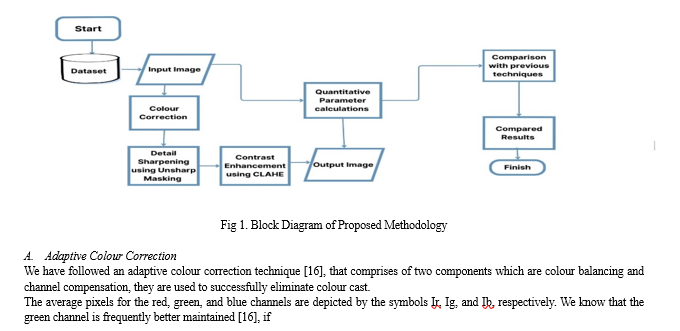
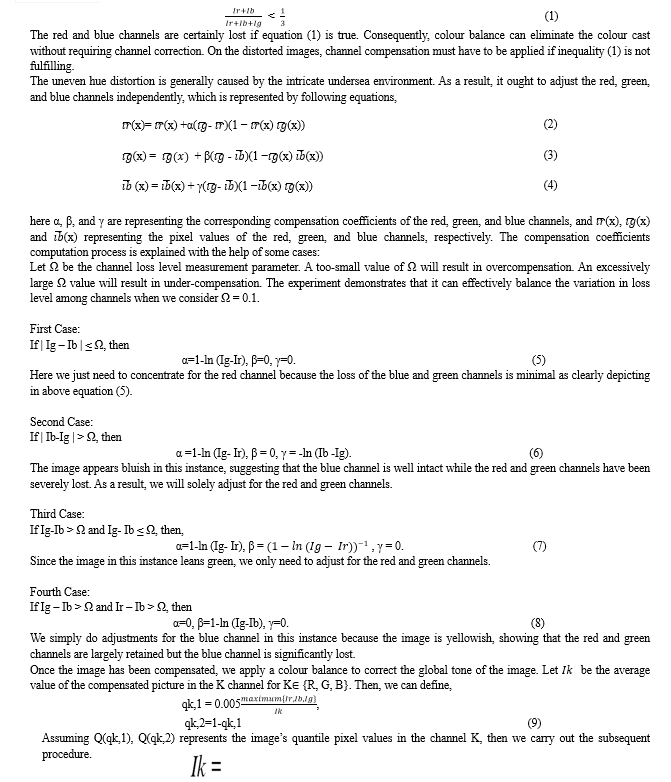
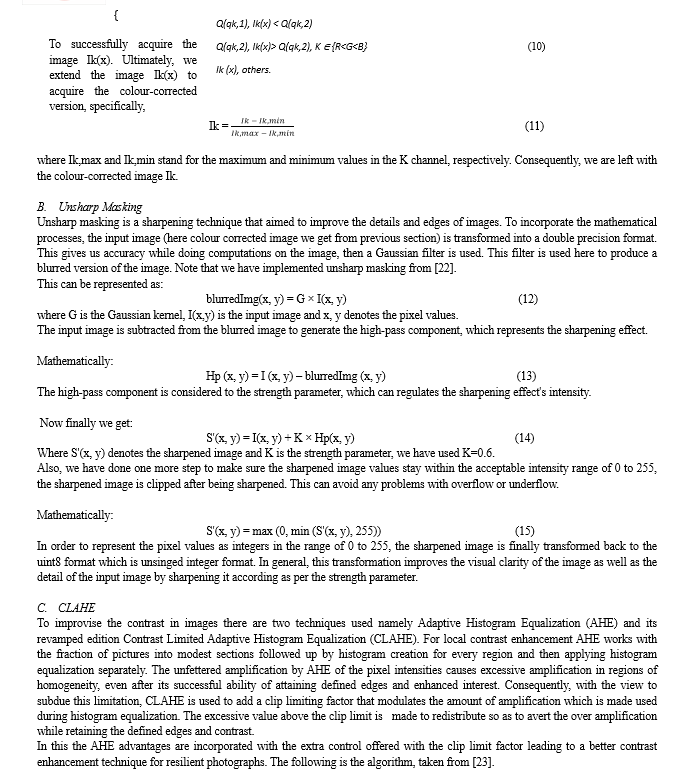
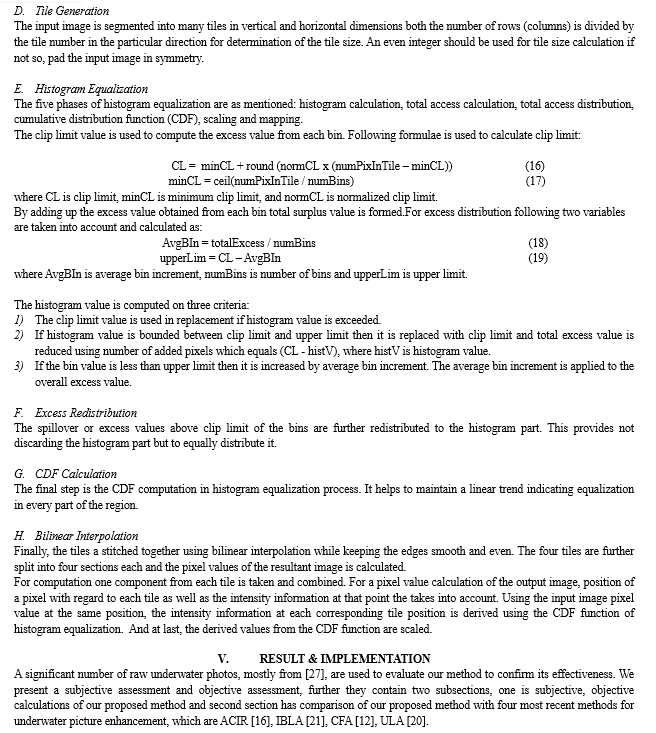
A. Subjective Assessment
The raw underwater images are obtained by UIEB [27], the following figures 2, 3 &4 show the subjective evaluation of various photos using our proposed method. It clearly represents that our proposed method has significantly enhanced the raw degraded images. Similarly Figure 5, 6 illustrates, the comparison with different techniques. The IBLA algorithm struggles to address colour deterioration issues in images. On the other-hand ACIR is able to handle different colour distortions and also maintains the natural texture of the image. Similarly in Figure 6, CFA is unable to improve the visual quality of the whole image, however CFA can effectively recover the original colours of underwater images. ULA results show that colour distortions. Thus, our proposed algorithm can address several degradation issues, including colour correction, sharpening and contrast enhancement. In summary, our proposed algorithm can enhance the underwater images' subjective visual impact more effectively.
B. Objective Assessment
To objectively demonstrate the efficiency of our proposed method, PCQI [25], UCIQE [26], UIQM [24], and IE indices are chosen as the metrics for evaluating various algorithms. The contrast difference between two photos is compared using PCQI. A higher value of PCQI rating denotes improved enhanced image visibility. The chroma, saturation, and contrast of underwater photos are reflected by metric indices UCIQE. The image quality is significantly improved with a higher UCIQE value. Human vision, which captures the colour contrast, and visual clarity of underwater images, is highly linked to UIQM. Greater consistency in the upgraded photos is indicated by a higher UIQM value. IE displays the depth of picture data. The enhanced image has more detailed information the higher its IE rating.
The UIEB [27] datasets were used for the objective comparisons. There are approximately 890 photos of various underwater sceneries in the UIEB dataset. Table 1, 2, 3 displays the results of the objective evaluation we have obtained by our proposed method. In the same way table 4, 5 represents the objective comparison with our method to the results produced by the techniques [16], [21], [12], [20], respectively. Note that tables represent the average values of indices Therefore, it is clear from that, our algorithm performed the highest and second highest on the PCQI, UCIQE, UIQM, and IE indexes on the UIEB datasets.
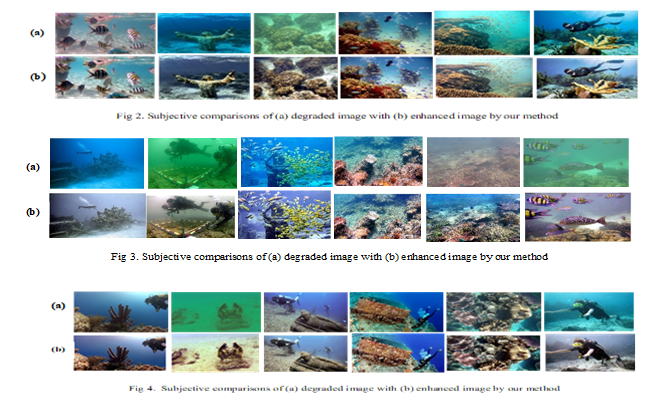

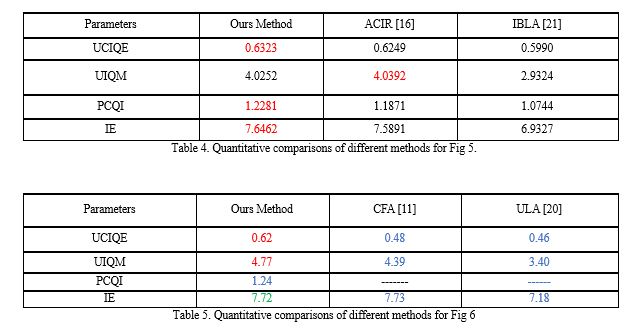
Conclusion
Our proposed method has successfully applied three different algorithm which are Adaptive Colour Correction, Unsharp Masking, and at the last Contrast-Limited Adaptive Histogram Equalization (CLAHE) all these are collectively used to improve the image quality through a combination of subjective and objective evaluations. Several real-world underwater images are provided as input and subjective evaluation depicted our results visually, whereas objective comparisons have been done on the basis of four quantitative measures like UIQM, UCIQE, PCQI and IE have demonstrated significant progress. The foundation for future image enhancement techniques, we will parameters refer to other robust algorithms which aim to strike a balance between perceived quality of the image and values of parameters
References
[1] F. Shafuda and H. Kondo, ‘‘A simple method for backscattered light estimation and image restoration in turbid water,’’ in Proc. OCEANS, San Diego, CA, USA, Sep. 2021, pp. 1–6, doi: 10.23919/OCEANS44145.2021.9705704. [2] A. S. A. Ghani, ‘‘Image contrast enhancement using an integration of recursive-overlapped contrast limited adaptive histogram specification and dual-image wavelet fusion for the high visibility of deep underwater image,’’ Ocean Eng., vol. 162, pp. 224–238, Aug. 2018, doi: 10.1016/j.oceaneng.2018.05.027. [3] C.O. Ancuti, C. Ancuti, C. De Vleeschouwer, and P. Bekaert, ‘‘Color balance and fusion for underwater image enhancement,’’ IEEE Trans. Image Process., vol. 27, no. 1, pp. 379–393, Jan. 2018, doi: 10.1109/TIP.2017.2759252 [4] W. Zhang, P. Zhuang, H.-H. Sun, G. Li, S. Kwong, and C. Li, ‘‘Underwater image enhancement via minimal color loss and locally adaptive contrast enhancement,’’ IEEE Trans. Image Process., vol. 31, pp. 3997–4010, 2022, doi: 10.1109/TIP.2022.3177129. [5] W. Zhang, L. Dong, and W. Xu, ‘‘Retinex-inspired color correction and detail preserved fusion for underwater image enhancement,’’ Comput. Electron. Agricult., vol. 192, Jan. 2022, Art. no. 106585, doi: 10.1016/j.compag.2021.106585. [6] W. L. Luo, S. Q. Duan, and J. W. Zheng, ‘‘Underwater image restoration and enhancement based on a fusion algorithm with color balance, contrast optimization, and histogram stretching,’’ IEEE Access, vol. 9, pp. 31792–31804, 2021, doi: 10.1109/ACCESS.2021.3060947. [7] C. Dai, M. Lin, J. Wang, and X. Hu, ‘‘Dual-purpose method for underwater and low-light image enhancement via image layer separation,’’ IEEE Access, vol. 7, pp. 178685–178698, 2019, doi: 10.1109/ACCESS.2019.2958078. [8] P. Liu, G. Y. Wang, H. Qi, C. F. Zhang, H. Y. Zheng, and Z. B. Yu, ‘‘Underwater image enhancement with a deep residual framework,’’ IEEE Access, vol. 7, pp. 94614–94629, 2019, doi: 10.1109/ACCESS.2019.2928976. [9] Z. Fu, X. Lin, W. Wang, Y. Huang, and X. Ding, ‘‘Underwater image enhancement via learning water type desensitized representations,’’ in Proc. IEEE Int. Conf. Acoust., Speech Signal Process. (ICASSP), Singapore, May 2022, pp. 2764–2768, doi: 10.1109/ICASSP43922.2022.9747758. [10] W. Zhang, G. Li, and Z. Ying, ‘‘A new underwater image enhancing method via color correction and illumination adjustment,’’ in Proc. IEEE Vis. Commun. Image Process. (VCIP), St. Petersburg, FL, USA, Dec. 2017, pp. 1–4, doi: 10.1109/VCIP.2017.8305027. [11] C. Li, S. Tang, Kwan, H. K., J. Yan, & T. Zhou, “Color Correction Based on CFA and Enhancement Based on Retinex With Dense Pixels for Underwater Images,” IEEE Access, vol. 8, pp. 155732-155741, 2020, doi: 10.1109/ACCESS.2020.3019354 [12] W. Zhang, X. Pan, X. Xie, L. Li, Z. Wang, and C. Han, \"Color correction and adaptive contrast enhancement for underwater image enhancement,\" IEEE Transactions on Image Processing, vol. 31, no. 5, pp. 5442-5455, May 2022. [13] S. Jin, P. Qu, Y. Zheng, W. Zhao and W. Zhang, “Color Correction and Local Contrast Enhancement for Underwater Image Enhancement,” in IEEE Access, vol. 10, pp. 119193-119205, 2022. [14] K. Wang, L. Shen, Y. Lin, M. Li, and Q. Zhao, \"Joint iterative color correction and dehazing for underwater image enhancement,\" IEEE Robotics and Automation Letters, vol. 6, no. 3, pp. 5121-5130, July 2021. [15] X. Fu and X. Cao, \"Underwater image enhancement with global-local networks and compressed-histogram equalization,\" IEEE Transactions on Image Processing, vol. 31, no. 5, pp. 5442-5455, May 2022. [16] S. Lin, Z. Li, F. Zheng, Q. Zhao and S. Li, “Underwater Image Enhancement Based on Adaptive Color Correction and Improved Retinex Algorithm,” in IEEE Access, vol. 11, pp. 27620-27630, 2023. [17] W. Song, Y. Wang, D. Huang, A. Liotta, and C. Perra, \"Enhancement of underwater images with statistical model of background light and optimization of transmission map,\" IEEE Transactions on Image Processing, vol. 31, no. 5, pp. 5442-5455, May 2024. [18] W. Zhang, L. Dong, T. Zhang, and W. Xu, \"Enhancing underwater image via color correction and Bi-interval contrast enhancement,\" IEEE Transactions on Image Processing, vol. 31, no. 5, pp. 3997-4010, May 2022. [19] W. Song, Y. Wang, D. Huang, A. Liotta, and C. Perra, \"Enhancement of Underwater Images with Statistical Model of Background Light and Optimization of Transmission Map,\" arXiv:1906.07661 [eess.IV], Jun. 2019. [20] Hanmante, Bhagyashree P., and Manisha Ingle. \"Underwater image restoration based on light absorption.\" In 2018 Fourth International Conference on Computing Communication Control and Automation (ICCUBEA), pp. 1-4. IEEE, 2018. [21] Peng, Yan-Tsung, and Pamela C. Cosman. \"Underwater image restoration based on image blurriness and light absorption.\" IEEE transactions on image processing 26, no. 4 (2017): 1579-1594 [22] R. C. Gonzales and R. E. Woods, Digital Image Processing 4th Edition, Page 29 [23] Karel Zuiderveld, \"Contrast Limited Adaptive Histogram Equalization\", Graphics Gems IV, p. 474-485, code: p. 479-484. [24] Panetta, Karen, Chen Gao, and Sos Agaian. \"Human-visual-system-inspired underwater image quality measures.\" IEEE Journal of Oceanic Engineering 41, no. 3 (2015): 541-551 [25] Wang, Shiqi, Kede Ma, Hojatollah Yeganeh, Zhou Wang, and Weisi Lin. \"A patch-structure representation method for quality assessment of contrast changed images.\" IEEE Signal Processing Letters 22, no. 12 (2015): 2387-2390 [26] Yang, Miao, and Arcot Sowmya. \"An underwater color image quality evaluation metric.\" IEEE Transactions on Image Processing 24, no. 12 (2015): 6062-6071. [27] C. Li et al., \"An Underwater Image Enhancement Benchmark Dataset and Beyond,\" in IEEE Transactions on Image Processing, vol. 29, pp. 4376-4389, 2020, doi:10.1109/TIP.2019.2955241. [28] Wu, Shengcong, Ting Luo, Gangyi Jiang, Mei Yu, Haiyong Xu, Zhongjie Zhu, and Yang Song. \"A two-stage underwater enhancement network based on structure decomposition and characteristics of underwater imaging.\" IEEE Journal of Oceanic Engineering 46, no. 4 (2021): 1213-1227.
Copyright
Copyright © 2024 Sumbul Zaheer, Shweta Dwivedi, Yashvi Srivastava, Prof. Awanish Kumar Shukla. This is an open access article distributed under the Creative Commons Attribution License, which permits unrestricted use, distribution, and reproduction in any medium, provided the original work is properly cited.

Download Paper
Paper Id : IJRASET62740
Publish Date : 2024-05-26
ISSN : 2321-9653
Publisher Name : IJRASET
DOI Link : Click Here
 Submit Paper Online
Submit Paper Online

